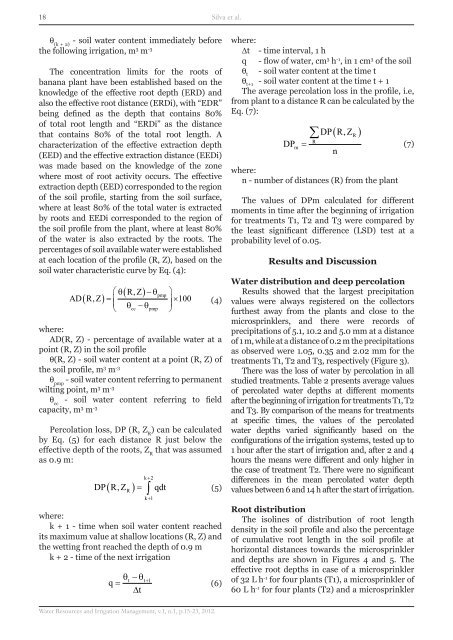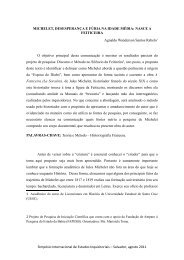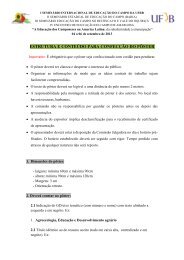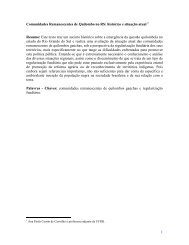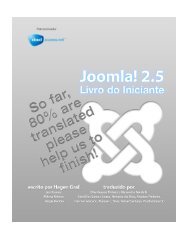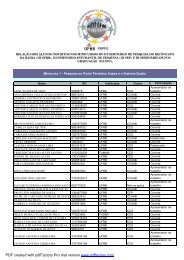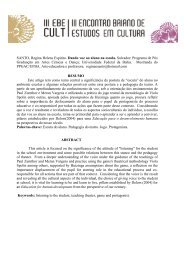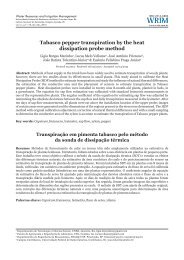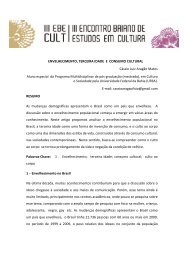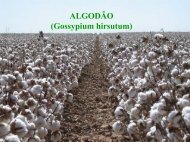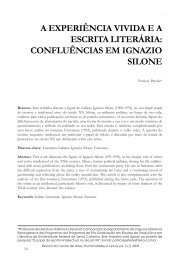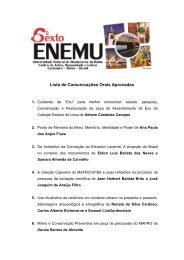Sensor placement for irrigation scheduling in banana using ... - UFRB
Sensor placement for irrigation scheduling in banana using ... - UFRB
Sensor placement for irrigation scheduling in banana using ... - UFRB
You also want an ePaper? Increase the reach of your titles
YUMPU automatically turns print PDFs into web optimized ePapers that Google loves.
18Silva et al.q (k + 2)- soil water content immediately be<strong>for</strong>ethe follow<strong>in</strong>g <strong>irrigation</strong>, m 3 m -3The concentration limits <strong>for</strong> the roots of<strong>banana</strong> plant have been established based on theknowledge of the effective root depth (ERD) andalso the effective root distance (ERDi), with “EDR”be<strong>in</strong>g def<strong>in</strong>ed as the depth that conta<strong>in</strong>s 80%of total root length and “ERDi” as the distancethat conta<strong>in</strong>s 80% of the total root length. Acharacterization of the effective extraction depth(EED) and the effective extraction distance (EEDi)was made based on the knowledge of the zonewhere most of root activity occurs. The effectiveextraction depth (EED) corresponded to the regionof the soil profile, start<strong>in</strong>g from the soil surface,where at least 80% of the total water is extractedby roots and EEDi corresponded to the region ofthe soil profile from the plant, where at least 80%of the water is also extracted by the roots. Thepercentages of soil available water were establishedat each location of the profile (R, Z), based on thesoil water characteristic curve by Eq. (4):⎛ θ( RZ , )− θAD( RZ , )=⎜⎝ θcc− θpmppmp⎞⎟ × 100⎠where:AD(R, Z) - percentage of available water at apo<strong>in</strong>t (R, Z) <strong>in</strong> the soil profileq(R, Z) - soil water content at a po<strong>in</strong>t (R, Z) ofthe soil profile, m 3 m -3q pmp- soil water content referr<strong>in</strong>g to permanentwilt<strong>in</strong>g po<strong>in</strong>t, m 3 m -3q cc- soil water content referr<strong>in</strong>g to fieldcapacity, m 3 m -3Percolation loss, DP (R, Z R) can be calculatedby Eq. (5) <strong>for</strong> each distance R just below theeffective depth of the roots, Z Rthat was assumedas 0.9 m:DP( RZ , )=Rk+2∫k+1qdtwhere:k + 1 - time when soil water content reachedits maximum value at shallow locations (R, Z) andthe wett<strong>in</strong>g front reached the depth of 0.9 mk + 2 - time of the next <strong>irrigation</strong>θt− θtq = + 1∆t(4)(5)(6)where:Dt - time <strong>in</strong>terval, 1 hq - flow of water, cm 3 h -1 , <strong>in</strong> 1 cm 3 of the soilq t- soil water content at the time tq t+1- soil water content at the time t + 1The average percolation loss <strong>in</strong> the profile, i.e,from plant to a distance R can be calculated by theEq. (7):DPm∑ DP RZ ,R=n( )where:n - number of distances (R) from the plantThe values of DPm calculated <strong>for</strong> differentmoments <strong>in</strong> time after the beg<strong>in</strong>n<strong>in</strong>g of <strong>irrigation</strong><strong>for</strong> treatments T1, T2 and T3 were compared bythe least significant difference (LSD) test at aprobability level of 0.05.Results and DiscussionWater distribution and deep percolationResults showed that the largest precipitationvalues were always registered on the collectorsfurthest away from the plants and close to themicrospr<strong>in</strong>klers, and there were records ofprecipitations of 5.1, 10.2 and 5.0 mm at a distanceof 1 m, while at a distance of 0.2 m the precipitationsas observed were 1.05, 0.35 and 2.02 mm <strong>for</strong> thetreatments T1, T2 and T3, respectively (Figure 3).There was the loss of water by percolation <strong>in</strong> allstudied treatments. Table 2 presents average valuesof percolated water depths at different momentsafter the beg<strong>in</strong>n<strong>in</strong>g of <strong>irrigation</strong> <strong>for</strong> treatments T1, T2and T3. By comparison of the means <strong>for</strong> treatmentsat specific times, the values of the percolatedwater depths varied significantly based on theconfigurations of the <strong>irrigation</strong> systems, tested up to1 hour after the start of <strong>irrigation</strong> and, after 2 and 4hours the means were different and only higher <strong>in</strong>the case of treatment T2. There were no significantdifferences <strong>in</strong> the mean percolated water depthvalues between 6 and 14 h after the start of <strong>irrigation</strong>.Root distributionThe isol<strong>in</strong>es of distribution of root lengthdensity <strong>in</strong> the soil profile and also the percentageof cumulative root length <strong>in</strong> the soil profile athorizontal distances towards the microspr<strong>in</strong>klerand depths are shown <strong>in</strong> Figures 4 and 5. Theeffective root depths <strong>in</strong> case of a microspr<strong>in</strong>klerof 32 L h -1 <strong>for</strong> four plants (T1), a microspr<strong>in</strong>kler of60 L h -1 <strong>for</strong> four plants (T2) and a microspr<strong>in</strong>klerR(7)Water Resources and Irrigation Management, v.1, n.1, p.15-23, 2012.


